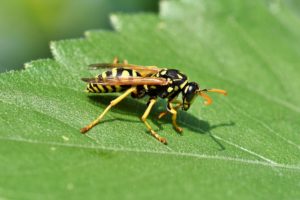Wasps are misunderstood and hated on far more than they should be. While they are more aggressive in defending themselves and their colonies than their smaller, fuzzy cousins, they don’t attack big animals like humans just because it’s fun. It’s genuinely because they believe that you are a threat.
Despite their reputation, wasps are still an important part of our environment. They are predators and hunt insects that we consider pests, like caterpillars and flies, something our fuzzy honey-producing bee friends can’t do. They are also pollinators! While not as proficient as bees, they are still important in helping the reproduction of plants.
That said, while wasps have a large negative press, it’s not for no reason at all. Wasps have a reputation for building their nests in the most inconspicuous of places, wherein you’d only know that you were too close if you see a swarm of wasps angrily headed your way. They are much more aggressive in defending their colonies and can chase you quite far if you are careless enough to stumble into one of their nests.
So, what should you do if you encounter one of these angry buzzing insects and want to stay on their good side?
Always keep your distance
You can treat wasps like you do bees. Except as insects with a much longer leash. After all, wasps, like bees, value their personal space, and can get aggressive to anyone that gets too close to it, as it may consider them a threat. This also includes someone approaching a wasp nest.
If you stay a considerable distance away from a wasp, it will most likely ignore you. But this being a wasp and not a bee, make sure you stay alert and cautious nonetheless, as it may decide that you are a threat later on after all.
Wasps actually have a much larger distance than bees as to how much you can approach them before they consider you a threat, so make sure you really keep your distance.
Don’t try to attract wasps
No ordinary person certainly wants to attract wasps on purpose. On the contrary, they would usually prefer to stay away if they so much as catch the glimpse of one’s presence nearby which is good, but one must not only consider themselves but their environment as well.
The thing about wasps is, like bees, they are quite attracted to sugar. This is due to the fact that they consume massive amounts of energy from the way they fly. As a result, this means that their attention will more than likely be drawn towards things like opened soda cans, beer, and other sugary drinks. This also applies to food item like ice cream, chocolate, and sweet sauces.
That’s right, your picnic may actually be sending a signal to nearby wasps that they are free for the taking!
The best way to avoid this, of course, is to make sure that you properly dispose of your sugary foods and drinks and that you never leave them unattended. You should also make sure that your drink doesn’t have any wasps outside or inside of them before taking a sip, or you might be in for a very painful surprise.
Watch for wasp hives… and stay away
Like with bees or any animal, you don’t want to approach a wasp’s nests at all, especially considering how protective and aggressive they are to threats.
A wasp nest looks like a gray paper ball with a swirl-like pattern visible on the outside. From below, one can see the cells that make up the inside of the nest. They can be found on trees, but wasp nests hanging under roof spaces, in bird boxes, and certain ground wasps like yellow jackets can even build their homes underground!
Don’t try to approach a wasp’s nest to remove it, you will likely be stung by angry defenders. If you really must remove the wasp nest because it is located in some important location (like your garden), call a professional to deal with it instead. Removing a wasp nest on its own is difficult already, but having to deal with angry defenders that can sting you makes things even worse.
If attacked, run like the wind and protect your face
On the most extreme of circumstances, you may be attacked by a wasp, in which case, you run. Run as fast as your legs can carry you in a straight line, and make sure that you’re protecting your face, because this is where wasps will usually target you with their stinging.
Wasps chase you a little farther than bees, around 50-100 feet usually. You’ll most certainly want to keep running though, and put even more distance between you and the wasp/s that you just pissed off.
And whatever you do, don’t drop down to pretend that you’re dead. This might work against a bear or a moose, but it won’t work against a swarm of angry wasps, who will continue to sting you. And the human body can only take so many wasp things before the venom starts really taking its toll on you. Even around 20~ stings can be seriously hazardous to the average human.
Another tip: don’t try to jump in body of water and swim underwater to hide yourself. Wasps are deterred by water, but they can simply wait for you to surface before going for the sting once again. This is the same tip for bees, but wasps are inherently more dangerous as they can sting you multiple times.

